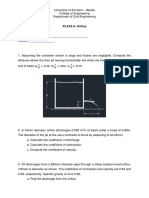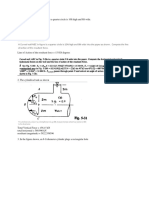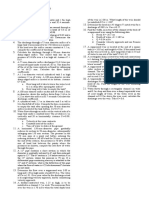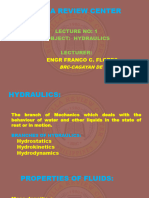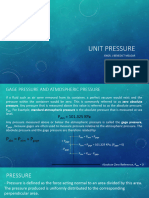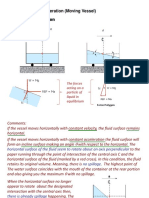A. Force Acting On The Gate:: Solution
Uploaded by
Fiel Ericson SolaresA. Force Acting On The Gate:: Solution
Uploaded by
Fiel Ericson SolaresSOLARES, FIEL ERICSON R.
BSCE 4 – MECHANICS OF FLUIDS: ACTIVITY NO. 2
1. A vertical rectangular gate as shown is 5 m wide, 9 m high is hinged at the top, has oil (sp.gr. = 0.84)
standing 10 m deep on one side, the liquid surface being under a pressure of -16.48 kPa.
a. Compute the hydrostatic force acting on the gate.
b. How far is the force acting below the hinged?
c. How much horizontal force applied at the bottom of is needed to open the gate?
SOLUTION:
a. Force acting on the gate:
𝝆𝒐𝒊𝒍
𝑺𝑮𝒐𝒊𝒍 =
𝝆𝒘
𝝆𝒐𝒊𝒍
0.84 =
1 𝑘𝑔⁄𝑚3
𝑘𝑔
𝝆𝒐𝒊𝒍 = 0.84 ⁄ 3
𝑚
𝑷 = 𝝆𝒐𝒊𝒍 𝒈𝒉𝟏
𝑘𝑔
16.48 𝑘𝑃𝑎 = (0.84 ⁄ 3 ) (9.81 𝑚⁄ 2 ) (ℎ1 )
𝑚 𝑠
𝒉𝟏 = 2 𝑚
𝒉𝟐 = 10 − ℎ1 − 4.5 = 3.5 𝑚
𝑭𝑷 = 𝜸𝒉𝑨
𝑭𝑷 = (𝝆𝒐𝒊𝒍 𝒈)𝒉𝑨
𝑭𝑷 = (0.84 𝑘𝑁⁄ 3 ) (9.81 𝑚⁄ 2 ) (3.5𝑚)(5𝑚)(9𝑚)
𝑚 𝑠
𝑭𝑷 = 1297.863 𝑘𝑁
b. Location of the force below the hinged:
𝑰𝒄
𝒆=
𝑺𝒄 𝑨
(𝟓)(𝟗)𝟑
[ ]
𝟏𝟐
𝒆 = (𝟑.𝟓)(𝟓)(𝟗)
𝒆 = 1.929 𝑚
𝑳𝒐𝒄𝒂𝒕𝒊𝒐𝒏 𝒐𝒇 𝒕𝒉𝒆 𝒇𝒐𝒓𝒄𝒆 𝒃𝒆𝒍𝒐𝒘 𝒕𝒉𝒆 𝒉𝒊𝒏𝒈𝒆𝒅 = 𝟏. 𝟗𝟐𝟗 + 𝟒. 𝟓
𝑳𝒐𝒄𝒂𝒕𝒊𝒐𝒏 𝒐𝒇 𝒕𝒉𝒆 𝒇𝒐𝒓𝒄𝒆 𝒃𝒆𝒍𝒐𝒘 𝒕𝒉𝒆 𝒉𝒊𝒏𝒈𝒆𝒅 = 𝟔. 𝟒𝟐𝟗 𝒎
c. Horizontal force needed to open the gate:
𝚺𝑴𝒐 = 𝟎
F(9) = 1297.863(6.429)
𝑭 = 𝟗𝟐𝟕. 𝟏𝟎𝟕 𝒌𝑵
2. A gate 3m high, 1.5m wide is hinged at point B and rests against a smooth wall at A. Point A is 1.8m
vertically above B. If the total depth of sea water is 4.6m
a. Compute the total hydrostatic force acting on the gate.
b. Compute the location of the center of pressure from B
c. Compute the horizontal force exerted by the wall at A.
SOLUTION:
a. Total hydrostatic force acting on the gate:
1.8
𝒉𝟏 = 4.6 − = 3.7 𝑚
2
𝑷 = 𝜸𝒔𝒘 𝒉𝟏 𝑨
𝑷 = (10.06 𝑘𝑁⁄ 3 ) (3.7𝑚)(1.5𝑚)(3𝑚)
𝑚
𝑷 = 𝟏𝟔𝟕. 𝟓𝟎 𝒌𝑵
b. Location of the center of pressure from B:
1.8
𝒕𝒂𝒏𝜽 =
2.4
𝜽 = 36.87°
3.7
𝑠𝑖𝑛 36.87° =
𝑦
𝒚 = 6.17 𝑚
𝑰𝒄
𝒆=
𝒚𝑨
1.5(3)3
[ 12 ]
𝒆= (6.17)(1.5)(3)
𝒆 = 0.122 𝑚
𝑳𝒐𝒄𝒂𝒕𝒊𝒐𝒏 𝒐𝒇 𝒕𝒉𝒆 𝒄𝒆𝒏𝒕𝒆𝒓 𝒐𝒇 𝒑𝒓𝒆𝒔𝒔𝒖𝒓𝒆 𝒇𝒓𝒐𝒎 𝑩 = 1.5 − 0.122
𝑳𝒐𝒄𝒂𝒕𝒊𝒐𝒏 𝒐𝒇 𝒕𝒉𝒆 𝒄𝒆𝒏𝒕𝒆𝒓 𝒐𝒇 𝒑𝒓𝒆𝒔𝒔𝒖𝒓𝒆 𝒇𝒓𝒐𝒎 𝑩 = 𝟏. 𝟑𝟖 𝒎
c. Horizontal force exerted by the wall at A:
𝚺𝑴𝒐 = 𝟎
F(sin 36.87°) (3) = 167.50(1.38)
𝑭 = 𝟏𝟐𝟖. 𝟒𝟐 𝒌𝑵
3. Assuming the unit weight of water = 9.79 kN/m3
a. Compute the horizontal component of the hydrostatic force on the quarter of circle face of the tank
shown.
b. Compute the vertical component of the hydrostatic force on the quarter of circle face of the tank
shown.
c. Compute the resultant force.
SOLUTIONS:
a. Horizontal component of the hydrostatic force:
̅𝑨
𝑷𝒉 = 𝜸𝒘 𝒉
𝑷 = 9.79 𝑘𝑁⁄ 3 (4.5𝑚)(1𝑚)(7𝑚)
𝑚
𝑷 = 𝟑𝟎𝟖. 𝟑𝟖𝟓 𝒌𝑵
b. Vertical component of the hydrostatic force:
𝑷𝒗 = 𝒘𝒆𝒊𝒈𝒉𝒕 𝒐𝒇 𝒘𝒂𝒕𝒆𝒓 𝒐𝒏 𝒕𝒉𝒆 𝒔𝒉𝒂𝒅𝒆𝒅 𝒂𝒓𝒆𝒂
𝜋(1)2
𝑷𝒗 = [(5𝑚)(7𝑚)(1𝑚) − (7)] (9.79 𝑘𝑁⁄ 3 )
4 𝑚
𝑷𝒗 = 𝟐𝟖𝟖. 𝟖𝟐𝟕 𝒌𝑵
c. Resultant force
𝑹 = √(288.827)2 + (308.385)2
𝑹 = 𝟒𝟐𝟐. 𝟓𝟏𝟗 𝒌𝑵
You might also like
- Hydraulics Chapter 5 Principles of Hydrodynamics Exercise ProblemsNo ratings yetHydraulics Chapter 5 Principles of Hydrodynamics Exercise Problems12 pages
- HF Using Manning Formula Sample Problems: Voice: Balase, Ann Maricar FNo ratings yetHF Using Manning Formula Sample Problems: Voice: Balase, Ann Maricar F11 pages
- HYDRAULICS TOPIC 1 FLUID PROPERTIES UNIT PRESSURE 23 May 2022No ratings yetHYDRAULICS TOPIC 1 FLUID PROPERTIES UNIT PRESSURE 23 May 202241 pages
- Solved Problems - Fluid Flow - Parallel Pipeline SystemsNo ratings yetSolved Problems - Fluid Flow - Parallel Pipeline Systems24 pages
- LESSON 3: Total Hydrostatic Force on Surface: Where: p = ϒh p = ϒysinθ100% (2)LESSON 3: Total Hydrostatic Force on Surface: Where: p = ϒh p = ϒysinθ7 pages
- Chapter 4 - Relative Equilibrium of Liquids (Moving Vessel)No ratings yetChapter 4 - Relative Equilibrium of Liquids (Moving Vessel)70 pages
- Total Hydrostatic Forces On Plane SurfaceNo ratings yetTotal Hydrostatic Forces On Plane Surface7 pages
- Ce 322 Fluid Mechanics Exercise No. 5 - Buoyancy & Statical Stability of Floating BodiesNo ratings yetCe 322 Fluid Mechanics Exercise No. 5 - Buoyancy & Statical Stability of Floating Bodies7 pages
- Given That Length of Pipe1, 2 3: Pipe 1 Length 1800 M: SolutionNo ratings yetGiven That Length of Pipe1, 2 3: Pipe 1 Length 1800 M: Solution4 pages
- ANS: (2.59807m/s2 Horizontal) (1.5m/s2 Vertical) (12.93725 Degree Angle That The Water Surface Makes With The Horizontal)No ratings yetANS: (2.59807m/s2 Horizontal) (1.5m/s2 Vertical) (12.93725 Degree Angle That The Water Surface Makes With The Horizontal)5 pages
- Solved Problems - Fluid Flow - Forces On Submerged Plane AreasNo ratings yetSolved Problems - Fluid Flow - Forces On Submerged Plane Areas24 pages
- Hydrostatic Pressure: Ammarali@wrec - Uoqasim.edu - IqNo ratings yetHydrostatic Pressure: Ammarali@wrec - Uoqasim.edu - Iq13 pages
- 5 Relative Equilibrium Tutorial SolutionNo ratings yet5 Relative Equilibrium Tutorial Solution19 pages
- 1S1920 - SW - Fluid Mechanics: Name DateNo ratings yet1S1920 - SW - Fluid Mechanics: Name Date12 pages
- Topic 4 Buoyancy, Stability of Floating BodiesNo ratings yetTopic 4 Buoyancy, Stability of Floating Bodies37 pages
- Toaz - Info Ce413 Tlo04 Weirs Solutionpdf PRNo ratings yetToaz - Info Ce413 Tlo04 Weirs Solutionpdf PR1 page
- Hydraulics - Topic 2 - Continuation - 26 May 2022No ratings yetHydraulics - Topic 2 - Continuation - 26 May 202227 pages
- CENG 197 - CE Competency Appraisal II Problem Set 3b Fluid Statics 2 - Hydrostatic Forces On Plane and Curved SurfacesNo ratings yetCENG 197 - CE Competency Appraisal II Problem Set 3b Fluid Statics 2 - Hydrostatic Forces On Plane and Curved Surfaces13 pages
- Transportation Engineering - Research StudyNo ratings yetTransportation Engineering - Research Study4 pages
- Earthquake Engineering Activity 4 - SeismographNo ratings yetEarthquake Engineering Activity 4 - Seismograph2 pages
- Davies Acry Color Tinting Color BrochureNo ratings yetDavies Acry Color Tinting Color Brochure1 page
- LECTURE2 Historical Antecedents of Science and TechnologyNo ratings yetLECTURE2 Historical Antecedents of Science and Technology5 pages
- Power Network Synthesis and Analysis with JupiterXT and primepowerNo ratings yetPower Network Synthesis and Analysis with JupiterXT and primepower14 pages
- Interest Rate Futures and Options OpenGammaNo ratings yetInterest Rate Futures and Options OpenGamma7 pages
- Engineering Data: Heat Pump Outdoor UnitNo ratings yetEngineering Data: Heat Pump Outdoor Unit10 pages
- Explain The Working Principle of A 555 Timer IC and Discuss Its Various Operating ModesNo ratings yetExplain The Working Principle of A 555 Timer IC and Discuss Its Various Operating Modes2 pages
- Bicycle Hazard Lights: Fundamentals of Electronics (Applied Subject)No ratings yetBicycle Hazard Lights: Fundamentals of Electronics (Applied Subject)33 pages
- Part and Assembly Modeling: With Solidworks 2014100% (1)Part and Assembly Modeling: With Solidworks 2014123 pages
- UTR LM A 5 UTR Language Model For DecodingNo ratings yetUTR LM A 5 UTR Language Model For Decoding13 pages
- Equipment Operational Reliability Evaluation MethoNo ratings yetEquipment Operational Reliability Evaluation Metho9 pages

